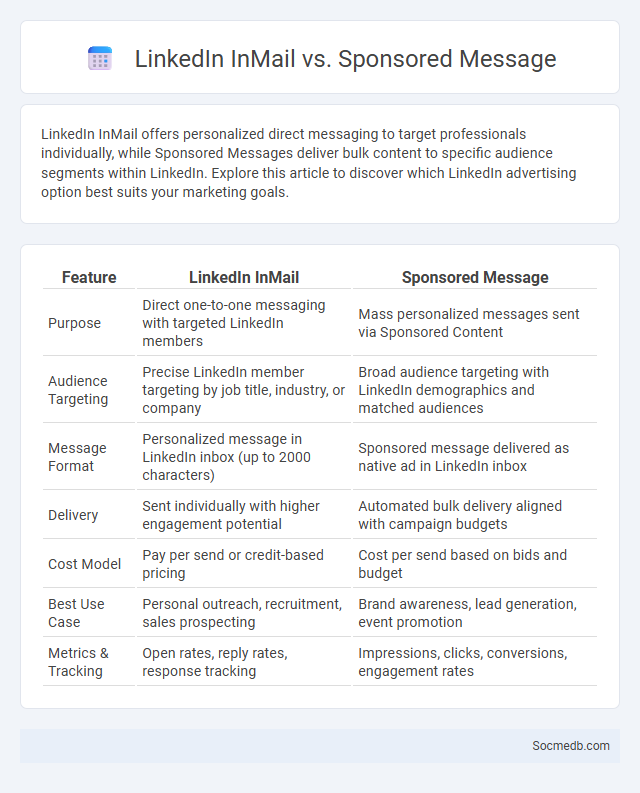
Photo illustration: LinkedIn InMail vs Sponsored Message
LinkedIn InMail offers personalized direct messaging to target professionals individually, while Sponsored Messages deliver bulk content to specific audience segments within LinkedIn. Explore this article to discover which LinkedIn advertising option best suits your marketing goals.
Table of Comparison
| Feature | LinkedIn InMail | Sponsored Message |
|---|---|---|
| Purpose | Direct one-to-one messaging with targeted LinkedIn members | Mass personalized messages sent via Sponsored Content |
| Audience Targeting | Precise LinkedIn member targeting by job title, industry, or company | Broad audience targeting with LinkedIn demographics and matched audiences |
| Message Format | Personalized message in LinkedIn inbox (up to 2000 characters) | Sponsored message delivered as native ad in LinkedIn inbox |
| Delivery | Sent individually with higher engagement potential | Automated bulk delivery aligned with campaign budgets |
| Cost Model | Pay per send or credit-based pricing | Cost per send based on bids and budget |
| Best Use Case | Personal outreach, recruitment, sales prospecting | Brand awareness, lead generation, event promotion |
| Metrics & Tracking | Open rates, reply rates, response tracking | Impressions, clicks, conversions, engagement rates |
Introduction to LinkedIn Messaging Solutions
LinkedIn Messaging Solutions transform the way professionals connect, offering tailored communication tools designed to enhance networking and business opportunities. You can leverage features like InMail, chatbots, and automated messaging to engage prospects effectively within a professional context. These solutions optimize outreach, foster meaningful interactions, and support your growth in the competitive LinkedIn ecosystem.
What is LinkedIn InMail?
LinkedIn InMail is a premium messaging feature that allows you to send direct messages to LinkedIn members who are not in your connections. This tool is essential for recruiters, sales professionals, and business developers aiming to engage prospects or initiate conversations without prior contact. Your ability to craft personalized InMail messages increases response rates and helps you build valuable professional relationships efficiently.
Understanding LinkedIn Sponsored Messages
LinkedIn Sponsored Messages enable targeted communication by delivering personalized messages directly to users' LinkedIn inboxes, enhancing engagement rates compared to traditional ads. Utilizing LinkedIn's advanced targeting options, marketers can segment audiences based on job title, industry, and professional interests, creating highly relevant campaigns. Measuring key performance indicators like open rates, click-through rates, and conversions provides critical insights for optimizing Sponsored Message effectiveness.
Key Differences Between InMail and Sponsored Messages
InMail allows you to send personalized messages directly to LinkedIn users outside your network, making it ideal for targeted outreach and recruitment campaigns. Sponsored Messages are paid ads sent as direct messages to predefined audiences, focusing on promoting content or offers with scalable reach. Understanding these distinctions helps you optimize your social media strategy by choosing between personalized engagement or broad advertising.
Audience Targeting and Reach
Effective audience targeting on social media leverages detailed demographic, behavioral, and interest data to connect your content with users most likely to engage, amplifying campaign performance and ROI. Platforms like Facebook and Instagram utilize advanced algorithms and custom audience tools to refine reach and boost relevant impressions, ensuring your message resonates with specific segments. By optimizing audience targeting, you increase your brand visibility and drive meaningful interactions that convert into growth.
Personalization and Engagement Rates
Social media platforms leverage advanced algorithms to deliver personalized content tailored to your interests, boosting engagement rates significantly. By analyzing user behavior and preferences, these systems enhance relevance, increasing the likelihood of interactions such as likes, comments, and shares. Higher engagement rates translate to improved visibility and stronger connections with your target audience.
Cost Structure and ROI Comparison
Analyzing social media cost structure reveals expenses primarily in content creation, advertising spend, and platform management tools. Your ROI depends on targeting accuracy, engagement rates, and conversion tracking that demonstrate cost efficiency compared to traditional marketing channels. Effective budgeting and performance analysis optimize returns while minimizing unnecessary expenditure in your social media campaigns.
Use Cases: When to Use InMail vs Sponsored Messages
InMail is ideal for personalized outreach to specific professionals, enabling direct communication for recruitment, sales, or networking efforts on LinkedIn. Sponsored Messages are better suited for broader engagement campaigns, delivering targeted ads to a larger audience without the need for one-to-one interaction. Choosing InMail is effective when tailored, high-impact conversations are needed, whereas Sponsored Messages maximize brand visibility and lead generation across user segments.
Best Practices for LinkedIn Messaging Campaigns
Craft personalized LinkedIn messages that directly address your recipient's interests and professional goals to increase engagement. Use clear calls-to-action and maintain a professional yet approachable tone, ensuring your message stands out in busy inboxes. Track response rates and adjust your messaging strategy based on performance data to maximize Your campaign's effectiveness.
Conclusion: Choosing the Right LinkedIn Messaging Tool
Selecting the right LinkedIn messaging tool hinges on aligning platform features with specific business objectives and audience engagement strategies. Tools offering advanced automation, personalized messaging capabilities, and robust analytics drive higher response rates and streamline lead generation. Prioritizing security and compliance ensures long-term trust and effectiveness in professional networking campaigns.
 socmedb.com
socmedb.com